Analysis of Information Systems and Enterprise Resource Planning
VerifiedAdded on 2023/01/13
|9
|2526
|66
Report
AI Summary
This report provides a comprehensive overview of information systems in a business context. It begins by introducing the concept of information systems and their significance in modern business operations, emphasizing their role in managing data, facilitating decision-making, and enhancing competitiveness. The report then delves into various types of information systems, including Transaction Processing Systems (TPS), Decision Support Systems (DSS), Executive Information Systems (EIS), Management Information Systems (MIS), Enterprise Resource Planning (ERP) systems, and Workflow systems, along with Expert systems. A significant portion of the report is dedicated to Enterprise Resource Planning (ERP) systems, explaining their functionality, modular structure, and integration capabilities. The report highlights the benefits of ERP systems, such as cost reduction, streamlined operations, supply chain optimization, improved customer satisfaction, and enhanced business flexibility. The report concludes by summarizing the key findings and recommending the adoption of ERP systems to improve business efficiency and achieve strategic goals. The report also includes references to support the information presented.
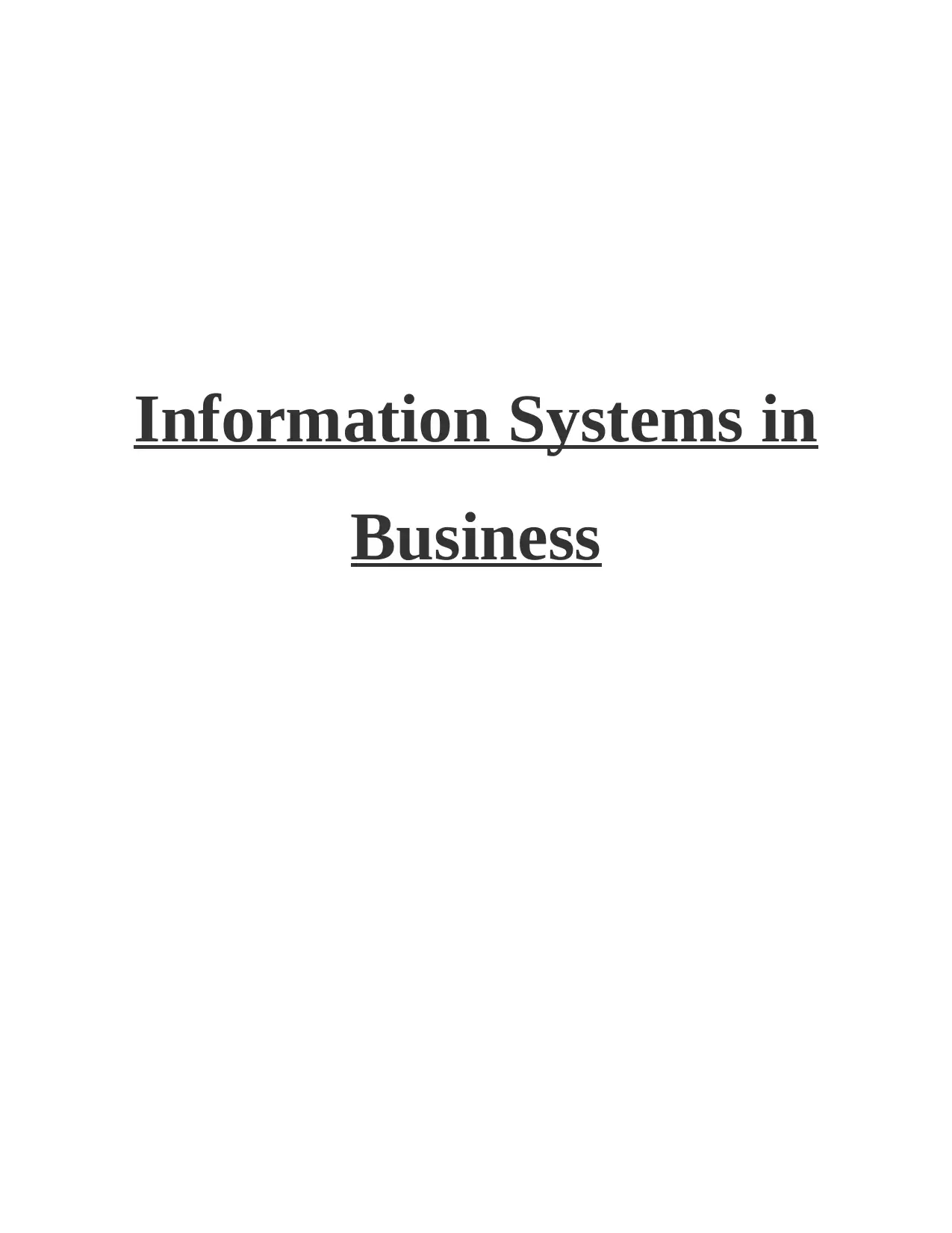
Information Systems in
Business
Business
Paraphrase This Document
Need a fresh take? Get an instant paraphrase of this document with our AI Paraphraser
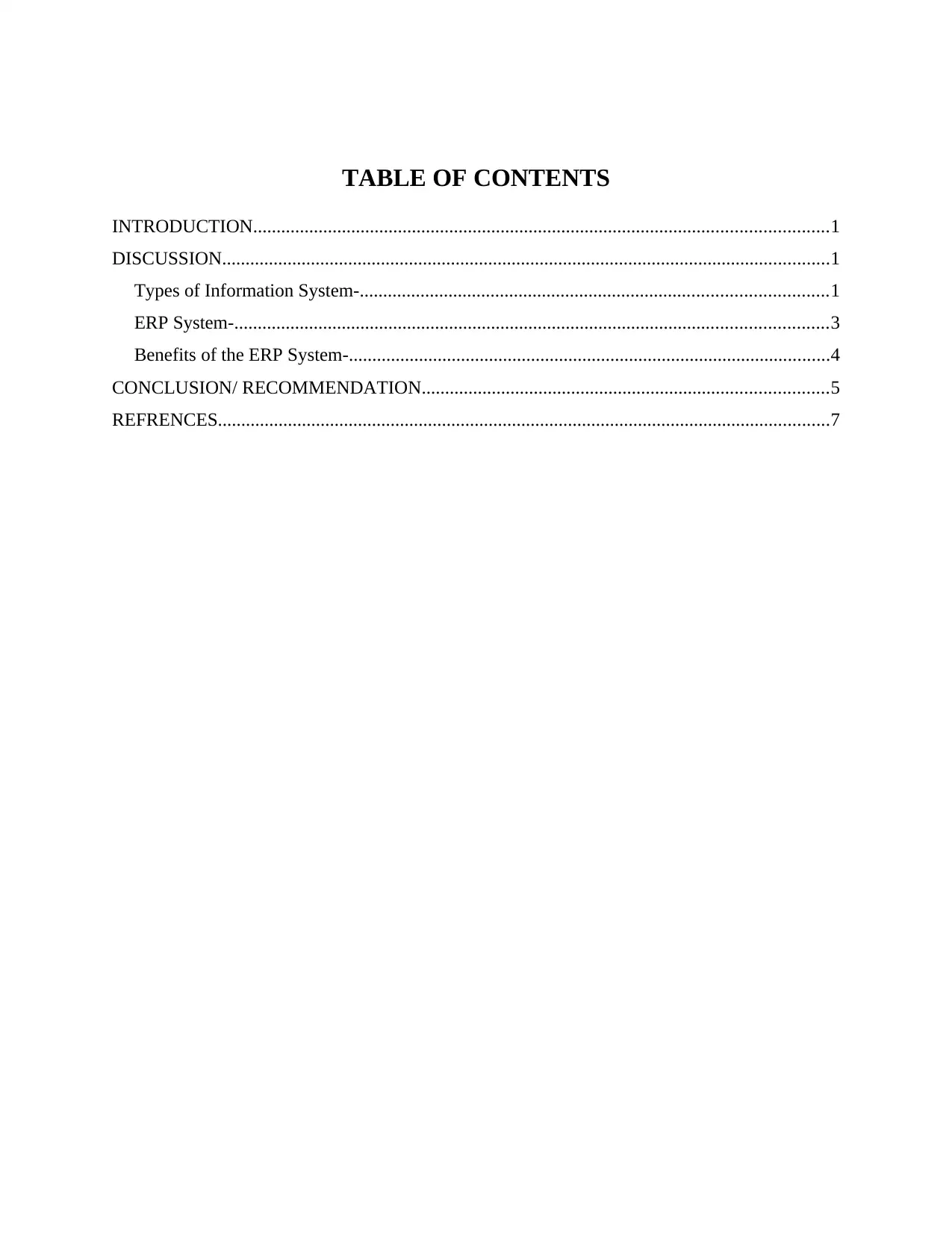
TABLE OF CONTENTS
INTRODUCTION...........................................................................................................................1
DISCUSSION..................................................................................................................................1
Types of Information System-....................................................................................................1
ERP System-...............................................................................................................................3
Benefits of the ERP System-.......................................................................................................4
CONCLUSION/ RECOMMENDATION.......................................................................................5
REFRENCES...................................................................................................................................7
INTRODUCTION...........................................................................................................................1
DISCUSSION..................................................................................................................................1
Types of Information System-....................................................................................................1
ERP System-...............................................................................................................................3
Benefits of the ERP System-.......................................................................................................4
CONCLUSION/ RECOMMENDATION.......................................................................................5
REFRENCES...................................................................................................................................7
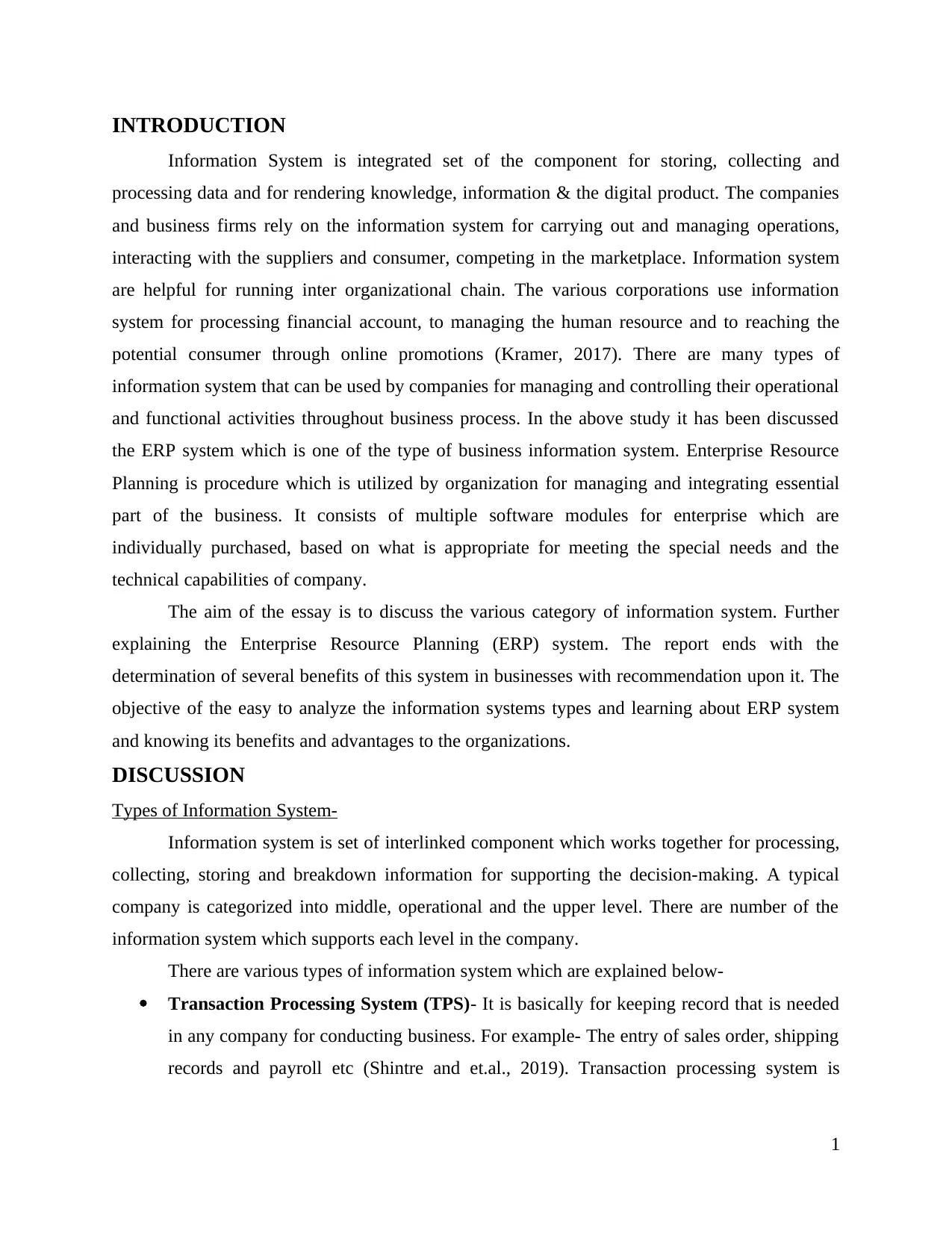
INTRODUCTION
Information System is integrated set of the component for storing, collecting and
processing data and for rendering knowledge, information & the digital product. The companies
and business firms rely on the information system for carrying out and managing operations,
interacting with the suppliers and consumer, competing in the marketplace. Information system
are helpful for running inter organizational chain. The various corporations use information
system for processing financial account, to managing the human resource and to reaching the
potential consumer through online promotions (Kramer, 2017). There are many types of
information system that can be used by companies for managing and controlling their operational
and functional activities throughout business process. In the above study it has been discussed
the ERP system which is one of the type of business information system. Enterprise Resource
Planning is procedure which is utilized by organization for managing and integrating essential
part of the business. It consists of multiple software modules for enterprise which are
individually purchased, based on what is appropriate for meeting the special needs and the
technical capabilities of company.
The aim of the essay is to discuss the various category of information system. Further
explaining the Enterprise Resource Planning (ERP) system. The report ends with the
determination of several benefits of this system in businesses with recommendation upon it. The
objective of the easy to analyze the information systems types and learning about ERP system
and knowing its benefits and advantages to the organizations.
DISCUSSION
Types of Information System-
Information system is set of interlinked component which works together for processing,
collecting, storing and breakdown information for supporting the decision-making. A typical
company is categorized into middle, operational and the upper level. There are number of the
information system which supports each level in the company.
There are various types of information system which are explained below-
Transaction Processing System (TPS)- It is basically for keeping record that is needed
in any company for conducting business. For example- The entry of sales order, shipping
records and payroll etc (Shintre and et.al., 2019). Transaction processing system is
1
Information System is integrated set of the component for storing, collecting and
processing data and for rendering knowledge, information & the digital product. The companies
and business firms rely on the information system for carrying out and managing operations,
interacting with the suppliers and consumer, competing in the marketplace. Information system
are helpful for running inter organizational chain. The various corporations use information
system for processing financial account, to managing the human resource and to reaching the
potential consumer through online promotions (Kramer, 2017). There are many types of
information system that can be used by companies for managing and controlling their operational
and functional activities throughout business process. In the above study it has been discussed
the ERP system which is one of the type of business information system. Enterprise Resource
Planning is procedure which is utilized by organization for managing and integrating essential
part of the business. It consists of multiple software modules for enterprise which are
individually purchased, based on what is appropriate for meeting the special needs and the
technical capabilities of company.
The aim of the essay is to discuss the various category of information system. Further
explaining the Enterprise Resource Planning (ERP) system. The report ends with the
determination of several benefits of this system in businesses with recommendation upon it. The
objective of the easy to analyze the information systems types and learning about ERP system
and knowing its benefits and advantages to the organizations.
DISCUSSION
Types of Information System-
Information system is set of interlinked component which works together for processing,
collecting, storing and breakdown information for supporting the decision-making. A typical
company is categorized into middle, operational and the upper level. There are number of the
information system which supports each level in the company.
There are various types of information system which are explained below-
Transaction Processing System (TPS)- It is basically for keeping record that is needed
in any company for conducting business. For example- The entry of sales order, shipping
records and payroll etc (Shintre and et.al., 2019). Transaction processing system is
1
⊘ This is a preview!⊘
Do you want full access?
Subscribe today to unlock all pages.

Trusted by 1+ million students worldwide
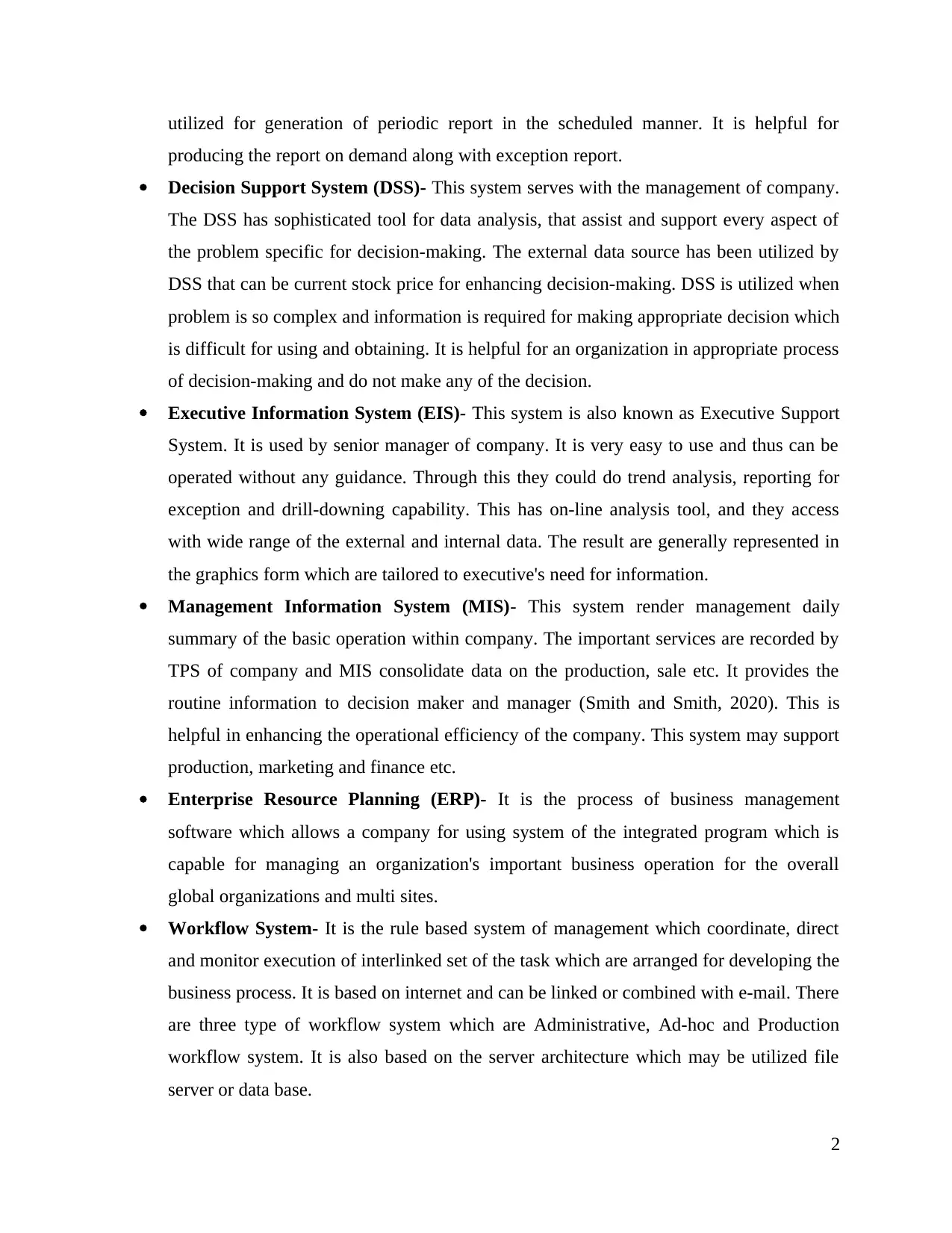
utilized for generation of periodic report in the scheduled manner. It is helpful for
producing the report on demand along with exception report.
Decision Support System (DSS)- This system serves with the management of company.
The DSS has sophisticated tool for data analysis, that assist and support every aspect of
the problem specific for decision-making. The external data source has been utilized by
DSS that can be current stock price for enhancing decision-making. DSS is utilized when
problem is so complex and information is required for making appropriate decision which
is difficult for using and obtaining. It is helpful for an organization in appropriate process
of decision-making and do not make any of the decision.
Executive Information System (EIS)- This system is also known as Executive Support
System. It is used by senior manager of company. It is very easy to use and thus can be
operated without any guidance. Through this they could do trend analysis, reporting for
exception and drill-downing capability. This has on-line analysis tool, and they access
with wide range of the external and internal data. The result are generally represented in
the graphics form which are tailored to executive's need for information.
Management Information System (MIS)- This system render management daily
summary of the basic operation within company. The important services are recorded by
TPS of company and MIS consolidate data on the production, sale etc. It provides the
routine information to decision maker and manager (Smith and Smith, 2020). This is
helpful in enhancing the operational efficiency of the company. This system may support
production, marketing and finance etc.
Enterprise Resource Planning (ERP)- It is the process of business management
software which allows a company for using system of the integrated program which is
capable for managing an organization's important business operation for the overall
global organizations and multi sites.
Workflow System- It is the rule based system of management which coordinate, direct
and monitor execution of interlinked set of the task which are arranged for developing the
business process. It is based on internet and can be linked or combined with e-mail. There
are three type of workflow system which are Administrative, Ad-hoc and Production
workflow system. It is also based on the server architecture which may be utilized file
server or data base.
2
producing the report on demand along with exception report.
Decision Support System (DSS)- This system serves with the management of company.
The DSS has sophisticated tool for data analysis, that assist and support every aspect of
the problem specific for decision-making. The external data source has been utilized by
DSS that can be current stock price for enhancing decision-making. DSS is utilized when
problem is so complex and information is required for making appropriate decision which
is difficult for using and obtaining. It is helpful for an organization in appropriate process
of decision-making and do not make any of the decision.
Executive Information System (EIS)- This system is also known as Executive Support
System. It is used by senior manager of company. It is very easy to use and thus can be
operated without any guidance. Through this they could do trend analysis, reporting for
exception and drill-downing capability. This has on-line analysis tool, and they access
with wide range of the external and internal data. The result are generally represented in
the graphics form which are tailored to executive's need for information.
Management Information System (MIS)- This system render management daily
summary of the basic operation within company. The important services are recorded by
TPS of company and MIS consolidate data on the production, sale etc. It provides the
routine information to decision maker and manager (Smith and Smith, 2020). This is
helpful in enhancing the operational efficiency of the company. This system may support
production, marketing and finance etc.
Enterprise Resource Planning (ERP)- It is the process of business management
software which allows a company for using system of the integrated program which is
capable for managing an organization's important business operation for the overall
global organizations and multi sites.
Workflow System- It is the rule based system of management which coordinate, direct
and monitor execution of interlinked set of the task which are arranged for developing the
business process. It is based on internet and can be linked or combined with e-mail. There
are three type of workflow system which are Administrative, Ad-hoc and Production
workflow system. It is also based on the server architecture which may be utilized file
server or data base.
2
Paraphrase This Document
Need a fresh take? Get an instant paraphrase of this document with our AI Paraphraser
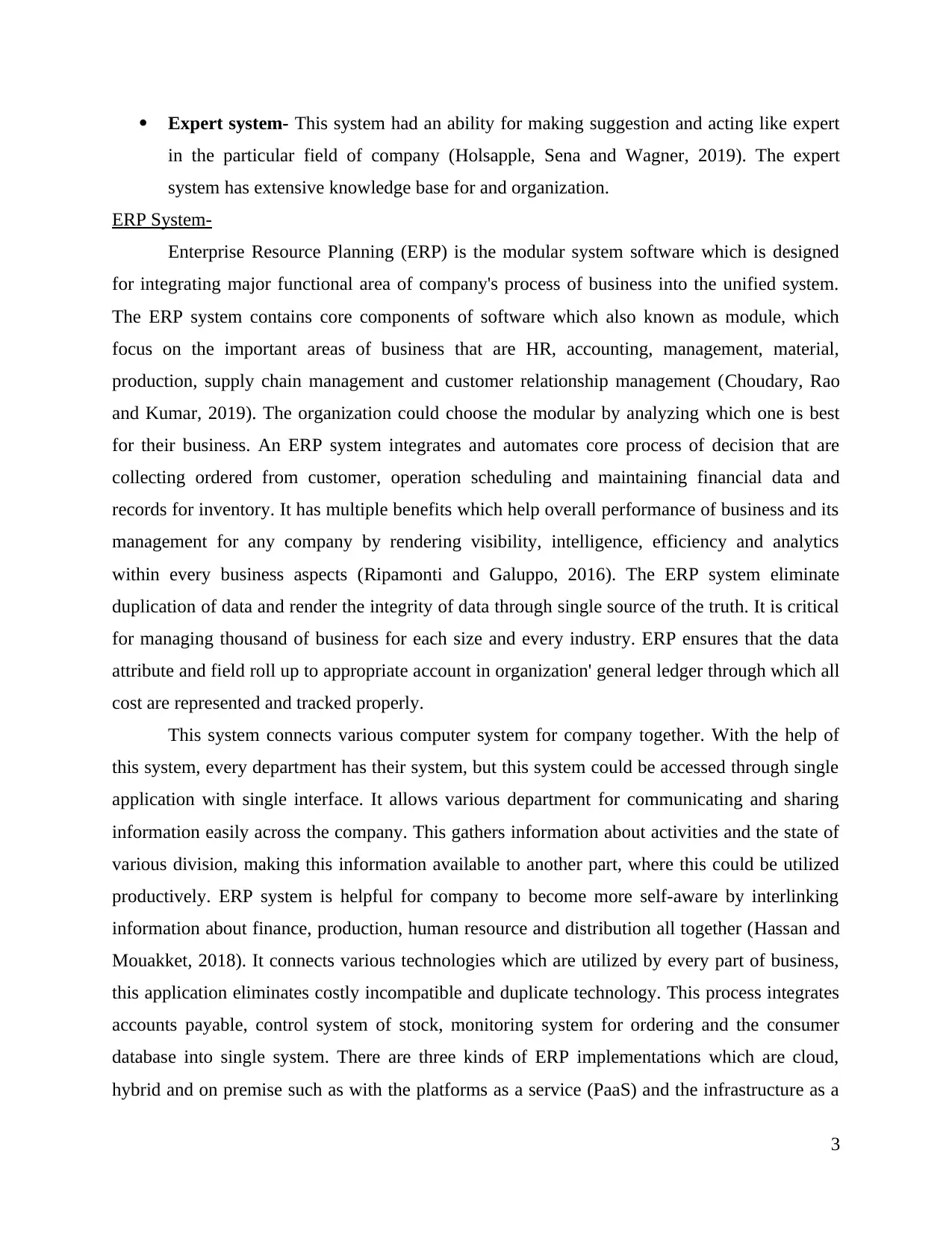
Expert system- This system had an ability for making suggestion and acting like expert
in the particular field of company (Holsapple, Sena and Wagner, 2019). The expert
system has extensive knowledge base for and organization.
ERP System-
Enterprise Resource Planning (ERP) is the modular system software which is designed
for integrating major functional area of company's process of business into the unified system.
The ERP system contains core components of software which also known as module, which
focus on the important areas of business that are HR, accounting, management, material,
production, supply chain management and customer relationship management (Choudary, Rao
and Kumar, 2019). The organization could choose the modular by analyzing which one is best
for their business. An ERP system integrates and automates core process of decision that are
collecting ordered from customer, operation scheduling and maintaining financial data and
records for inventory. It has multiple benefits which help overall performance of business and its
management for any company by rendering visibility, intelligence, efficiency and analytics
within every business aspects (Ripamonti and Galuppo, 2016). The ERP system eliminate
duplication of data and render the integrity of data through single source of the truth. It is critical
for managing thousand of business for each size and every industry. ERP ensures that the data
attribute and field roll up to appropriate account in organization' general ledger through which all
cost are represented and tracked properly.
This system connects various computer system for company together. With the help of
this system, every department has their system, but this system could be accessed through single
application with single interface. It allows various department for communicating and sharing
information easily across the company. This gathers information about activities and the state of
various division, making this information available to another part, where this could be utilized
productively. ERP system is helpful for company to become more self-aware by interlinking
information about finance, production, human resource and distribution all together (Hassan and
Mouakket, 2018). It connects various technologies which are utilized by every part of business,
this application eliminates costly incompatible and duplicate technology. This process integrates
accounts payable, control system of stock, monitoring system for ordering and the consumer
database into single system. There are three kinds of ERP implementations which are cloud,
hybrid and on premise such as with the platforms as a service (PaaS) and the infrastructure as a
3
in the particular field of company (Holsapple, Sena and Wagner, 2019). The expert
system has extensive knowledge base for and organization.
ERP System-
Enterprise Resource Planning (ERP) is the modular system software which is designed
for integrating major functional area of company's process of business into the unified system.
The ERP system contains core components of software which also known as module, which
focus on the important areas of business that are HR, accounting, management, material,
production, supply chain management and customer relationship management (Choudary, Rao
and Kumar, 2019). The organization could choose the modular by analyzing which one is best
for their business. An ERP system integrates and automates core process of decision that are
collecting ordered from customer, operation scheduling and maintaining financial data and
records for inventory. It has multiple benefits which help overall performance of business and its
management for any company by rendering visibility, intelligence, efficiency and analytics
within every business aspects (Ripamonti and Galuppo, 2016). The ERP system eliminate
duplication of data and render the integrity of data through single source of the truth. It is critical
for managing thousand of business for each size and every industry. ERP ensures that the data
attribute and field roll up to appropriate account in organization' general ledger through which all
cost are represented and tracked properly.
This system connects various computer system for company together. With the help of
this system, every department has their system, but this system could be accessed through single
application with single interface. It allows various department for communicating and sharing
information easily across the company. This gathers information about activities and the state of
various division, making this information available to another part, where this could be utilized
productively. ERP system is helpful for company to become more self-aware by interlinking
information about finance, production, human resource and distribution all together (Hassan and
Mouakket, 2018). It connects various technologies which are utilized by every part of business,
this application eliminates costly incompatible and duplicate technology. This process integrates
accounts payable, control system of stock, monitoring system for ordering and the consumer
database into single system. There are three kinds of ERP implementations which are cloud,
hybrid and on premise such as with the platforms as a service (PaaS) and the infrastructure as a
3
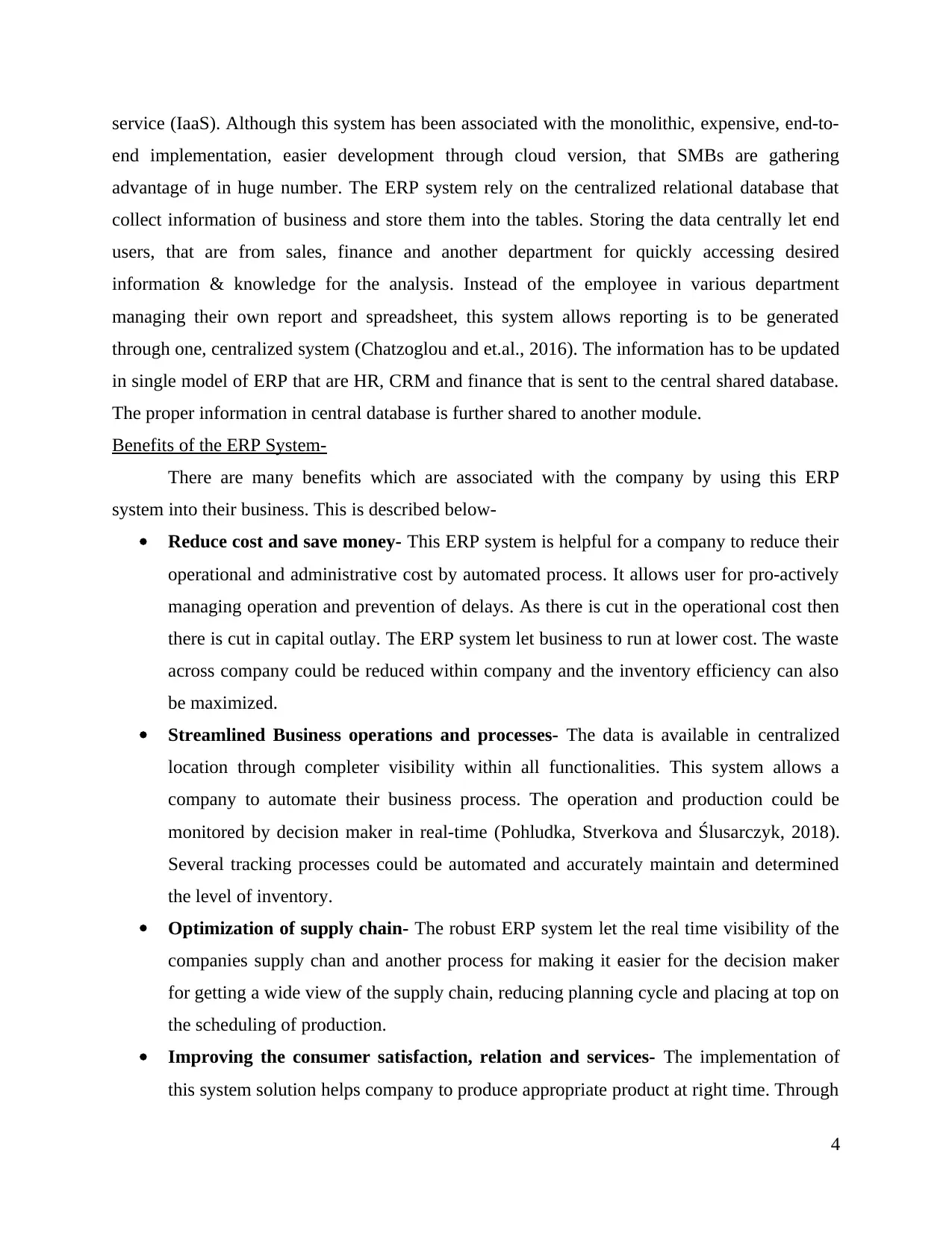
service (IaaS). Although this system has been associated with the monolithic, expensive, end-to-
end implementation, easier development through cloud version, that SMBs are gathering
advantage of in huge number. The ERP system rely on the centralized relational database that
collect information of business and store them into the tables. Storing the data centrally let end
users, that are from sales, finance and another department for quickly accessing desired
information & knowledge for the analysis. Instead of the employee in various department
managing their own report and spreadsheet, this system allows reporting is to be generated
through one, centralized system (Chatzoglou and et.al., 2016). The information has to be updated
in single model of ERP that are HR, CRM and finance that is sent to the central shared database.
The proper information in central database is further shared to another module.
Benefits of the ERP System-
There are many benefits which are associated with the company by using this ERP
system into their business. This is described below-
Reduce cost and save money- This ERP system is helpful for a company to reduce their
operational and administrative cost by automated process. It allows user for pro-actively
managing operation and prevention of delays. As there is cut in the operational cost then
there is cut in capital outlay. The ERP system let business to run at lower cost. The waste
across company could be reduced within company and the inventory efficiency can also
be maximized.
Streamlined Business operations and processes- The data is available in centralized
location through completer visibility within all functionalities. This system allows a
company to automate their business process. The operation and production could be
monitored by decision maker in real-time (Pohludka, Stverkova and Ślusarczyk, 2018).
Several tracking processes could be automated and accurately maintain and determined
the level of inventory.
Optimization of supply chain- The robust ERP system let the real time visibility of the
companies supply chan and another process for making it easier for the decision maker
for getting a wide view of the supply chain, reducing planning cycle and placing at top on
the scheduling of production.
Improving the consumer satisfaction, relation and services- The implementation of
this system solution helps company to produce appropriate product at right time. Through
4
end implementation, easier development through cloud version, that SMBs are gathering
advantage of in huge number. The ERP system rely on the centralized relational database that
collect information of business and store them into the tables. Storing the data centrally let end
users, that are from sales, finance and another department for quickly accessing desired
information & knowledge for the analysis. Instead of the employee in various department
managing their own report and spreadsheet, this system allows reporting is to be generated
through one, centralized system (Chatzoglou and et.al., 2016). The information has to be updated
in single model of ERP that are HR, CRM and finance that is sent to the central shared database.
The proper information in central database is further shared to another module.
Benefits of the ERP System-
There are many benefits which are associated with the company by using this ERP
system into their business. This is described below-
Reduce cost and save money- This ERP system is helpful for a company to reduce their
operational and administrative cost by automated process. It allows user for pro-actively
managing operation and prevention of delays. As there is cut in the operational cost then
there is cut in capital outlay. The ERP system let business to run at lower cost. The waste
across company could be reduced within company and the inventory efficiency can also
be maximized.
Streamlined Business operations and processes- The data is available in centralized
location through completer visibility within all functionalities. This system allows a
company to automate their business process. The operation and production could be
monitored by decision maker in real-time (Pohludka, Stverkova and Ślusarczyk, 2018).
Several tracking processes could be automated and accurately maintain and determined
the level of inventory.
Optimization of supply chain- The robust ERP system let the real time visibility of the
companies supply chan and another process for making it easier for the decision maker
for getting a wide view of the supply chain, reducing planning cycle and placing at top on
the scheduling of production.
Improving the consumer satisfaction, relation and services- The implementation of
this system solution helps company to produce appropriate product at right time. Through
4
⊘ This is a preview!⊘
Do you want full access?
Subscribe today to unlock all pages.

Trusted by 1+ million students worldwide
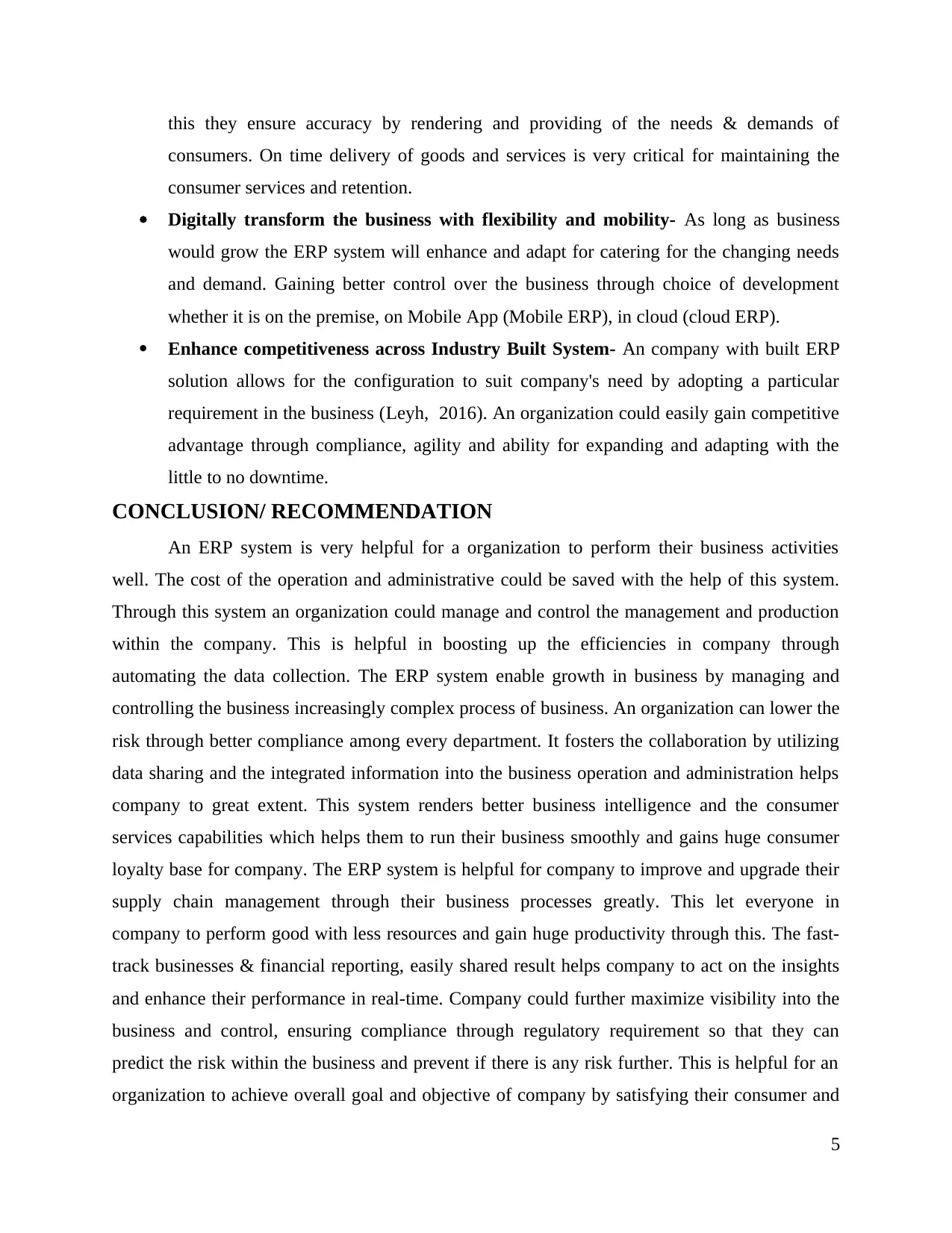
this they ensure accuracy by rendering and providing of the needs & demands of
consumers. On time delivery of goods and services is very critical for maintaining the
consumer services and retention.
Digitally transform the business with flexibility and mobility- As long as business
would grow the ERP system will enhance and adapt for catering for the changing needs
and demand. Gaining better control over the business through choice of development
whether it is on the premise, on Mobile App (Mobile ERP), in cloud (cloud ERP).
Enhance competitiveness across Industry Built System- An company with built ERP
solution allows for the configuration to suit company's need by adopting a particular
requirement in the business (Leyh, 2016). An organization could easily gain competitive
advantage through compliance, agility and ability for expanding and adapting with the
little to no downtime.
CONCLUSION/ RECOMMENDATION
An ERP system is very helpful for a organization to perform their business activities
well. The cost of the operation and administrative could be saved with the help of this system.
Through this system an organization could manage and control the management and production
within the company. This is helpful in boosting up the efficiencies in company through
automating the data collection. The ERP system enable growth in business by managing and
controlling the business increasingly complex process of business. An organization can lower the
risk through better compliance among every department. It fosters the collaboration by utilizing
data sharing and the integrated information into the business operation and administration helps
company to great extent. This system renders better business intelligence and the consumer
services capabilities which helps them to run their business smoothly and gains huge consumer
loyalty base for company. The ERP system is helpful for company to improve and upgrade their
supply chain management through their business processes greatly. This let everyone in
company to perform good with less resources and gain huge productivity through this. The fast-
track businesses & financial reporting, easily shared result helps company to act on the insights
and enhance their performance in real-time. Company could further maximize visibility into the
business and control, ensuring compliance through regulatory requirement so that they can
predict the risk within the business and prevent if there is any risk further. This is helpful for an
organization to achieve overall goal and objective of company by satisfying their consumer and
5
consumers. On time delivery of goods and services is very critical for maintaining the
consumer services and retention.
Digitally transform the business with flexibility and mobility- As long as business
would grow the ERP system will enhance and adapt for catering for the changing needs
and demand. Gaining better control over the business through choice of development
whether it is on the premise, on Mobile App (Mobile ERP), in cloud (cloud ERP).
Enhance competitiveness across Industry Built System- An company with built ERP
solution allows for the configuration to suit company's need by adopting a particular
requirement in the business (Leyh, 2016). An organization could easily gain competitive
advantage through compliance, agility and ability for expanding and adapting with the
little to no downtime.
CONCLUSION/ RECOMMENDATION
An ERP system is very helpful for a organization to perform their business activities
well. The cost of the operation and administrative could be saved with the help of this system.
Through this system an organization could manage and control the management and production
within the company. This is helpful in boosting up the efficiencies in company through
automating the data collection. The ERP system enable growth in business by managing and
controlling the business increasingly complex process of business. An organization can lower the
risk through better compliance among every department. It fosters the collaboration by utilizing
data sharing and the integrated information into the business operation and administration helps
company to great extent. This system renders better business intelligence and the consumer
services capabilities which helps them to run their business smoothly and gains huge consumer
loyalty base for company. The ERP system is helpful for company to improve and upgrade their
supply chain management through their business processes greatly. This let everyone in
company to perform good with less resources and gain huge productivity through this. The fast-
track businesses & financial reporting, easily shared result helps company to act on the insights
and enhance their performance in real-time. Company could further maximize visibility into the
business and control, ensuring compliance through regulatory requirement so that they can
predict the risk within the business and prevent if there is any risk further. This is helpful for an
organization to achieve overall goal and objective of company by satisfying their consumer and
5
Paraphrase This Document
Need a fresh take? Get an instant paraphrase of this document with our AI Paraphraser

maintaining a good relationship with them. Satisfied consumer will always stay with them for
long term. With the help of efficient operation and access to the real-time data's a company could
quickly react and identify to the upcoming & new opportunities.
6
long term. With the help of efficient operation and access to the real-time data's a company could
quickly react and identify to the upcoming & new opportunities.
6
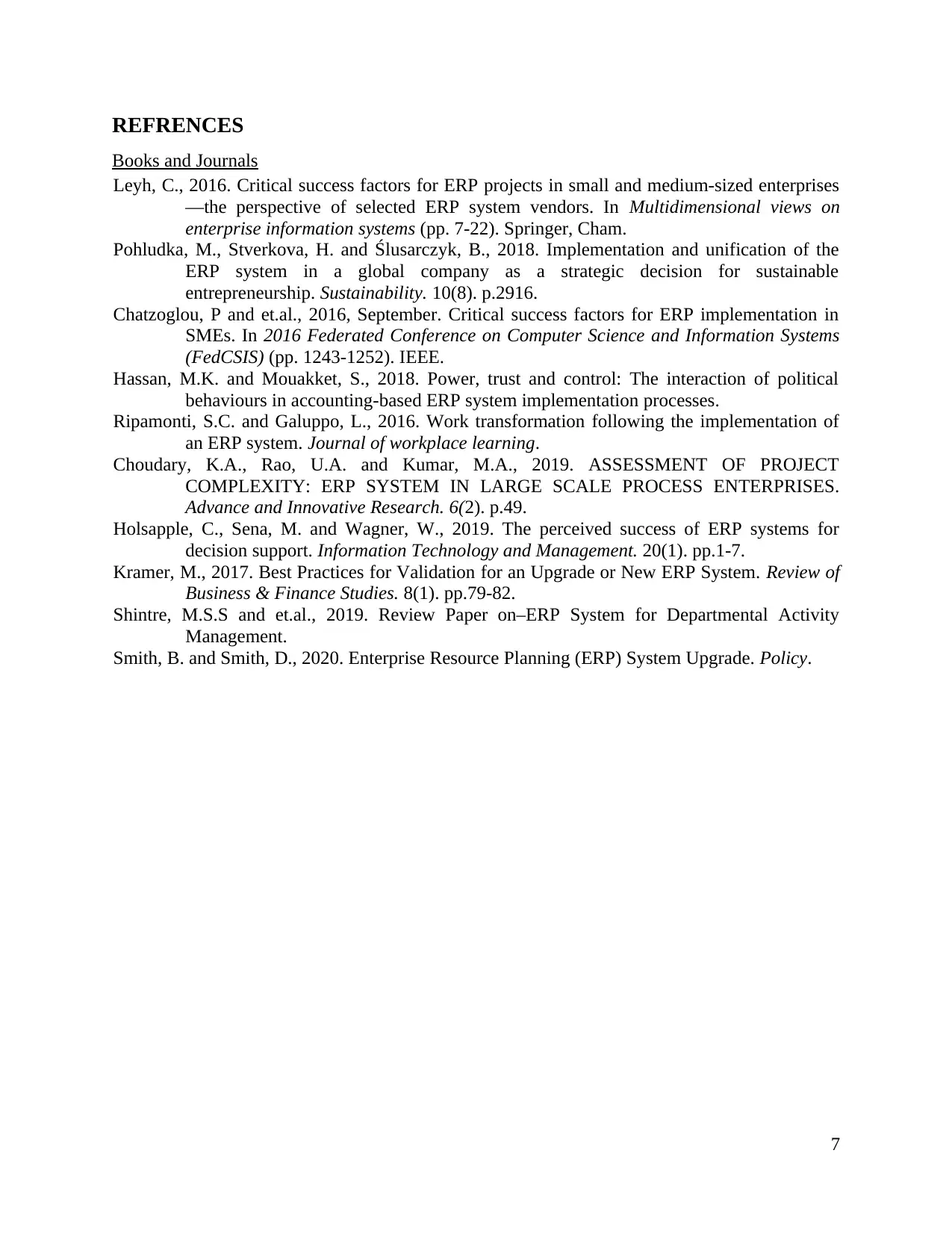
REFRENCES
Books and Journals
Leyh, C., 2016. Critical success factors for ERP projects in small and medium-sized enterprises
—the perspective of selected ERP system vendors. In Multidimensional views on
enterprise information systems (pp. 7-22). Springer, Cham.
Pohludka, M., Stverkova, H. and Ślusarczyk, B., 2018. Implementation and unification of the
ERP system in a global company as a strategic decision for sustainable
entrepreneurship. Sustainability. 10(8). p.2916.
Chatzoglou, P and et.al., 2016, September. Critical success factors for ERP implementation in
SMEs. In 2016 Federated Conference on Computer Science and Information Systems
(FedCSIS) (pp. 1243-1252). IEEE.
Hassan, M.K. and Mouakket, S., 2018. Power, trust and control: The interaction of political
behaviours in accounting-based ERP system implementation processes.
Ripamonti, S.C. and Galuppo, L., 2016. Work transformation following the implementation of
an ERP system. Journal of workplace learning.
Choudary, K.A., Rao, U.A. and Kumar, M.A., 2019. ASSESSMENT OF PROJECT
COMPLEXITY: ERP SYSTEM IN LARGE SCALE PROCESS ENTERPRISES.
Advance and Innovative Research. 6(2). p.49.
Holsapple, C., Sena, M. and Wagner, W., 2019. The perceived success of ERP systems for
decision support. Information Technology and Management. 20(1). pp.1-7.
Kramer, M., 2017. Best Practices for Validation for an Upgrade or New ERP System. Review of
Business & Finance Studies. 8(1). pp.79-82.
Shintre, M.S.S and et.al., 2019. Review Paper on–ERP System for Departmental Activity
Management.
Smith, B. and Smith, D., 2020. Enterprise Resource Planning (ERP) System Upgrade. Policy.
7
Books and Journals
Leyh, C., 2016. Critical success factors for ERP projects in small and medium-sized enterprises
—the perspective of selected ERP system vendors. In Multidimensional views on
enterprise information systems (pp. 7-22). Springer, Cham.
Pohludka, M., Stverkova, H. and Ślusarczyk, B., 2018. Implementation and unification of the
ERP system in a global company as a strategic decision for sustainable
entrepreneurship. Sustainability. 10(8). p.2916.
Chatzoglou, P and et.al., 2016, September. Critical success factors for ERP implementation in
SMEs. In 2016 Federated Conference on Computer Science and Information Systems
(FedCSIS) (pp. 1243-1252). IEEE.
Hassan, M.K. and Mouakket, S., 2018. Power, trust and control: The interaction of political
behaviours in accounting-based ERP system implementation processes.
Ripamonti, S.C. and Galuppo, L., 2016. Work transformation following the implementation of
an ERP system. Journal of workplace learning.
Choudary, K.A., Rao, U.A. and Kumar, M.A., 2019. ASSESSMENT OF PROJECT
COMPLEXITY: ERP SYSTEM IN LARGE SCALE PROCESS ENTERPRISES.
Advance and Innovative Research. 6(2). p.49.
Holsapple, C., Sena, M. and Wagner, W., 2019. The perceived success of ERP systems for
decision support. Information Technology and Management. 20(1). pp.1-7.
Kramer, M., 2017. Best Practices for Validation for an Upgrade or New ERP System. Review of
Business & Finance Studies. 8(1). pp.79-82.
Shintre, M.S.S and et.al., 2019. Review Paper on–ERP System for Departmental Activity
Management.
Smith, B. and Smith, D., 2020. Enterprise Resource Planning (ERP) System Upgrade. Policy.
7
⊘ This is a preview!⊘
Do you want full access?
Subscribe today to unlock all pages.

Trusted by 1+ million students worldwide
1 out of 9
Related Documents
Your All-in-One AI-Powered Toolkit for Academic Success.
+13062052269
info@desklib.com
Available 24*7 on WhatsApp / Email
![[object Object]](/_next/static/media/star-bottom.7253800d.svg)
Unlock your academic potential
Copyright © 2020–2026 A2Z Services. All Rights Reserved. Developed and managed by ZUCOL.





